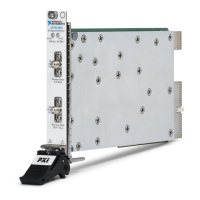NI PXI-5650/5651/5652 Calibration Procedure | © National Instruments | 15
Note The main frequency synthesis occurs between 1.6 GHz and 3.3 GHz using
one of four voltage-controlled oscillators (VCO). Frequencies outside this range are
generated by using dividers or multipliers. For frequencies lower than 1 GHz, the
SSB phase noise can be characterized by the following relationship (use the 1 GHz
measurement as your reference):
SSB Phase Noise
TEST
= SSB Phase Noise
REFERENCE
- 20log(n)
where
SSB Phase Noise
TEST
= SSB phase noise at the center frequency of interest
in dBc/Hz
SSB Phase Noise
REFERENCE
= SSB phase noise at the referenced center frequency
of interest in dBc/Hz
n = Reference/Test in Hz/Hz
Verifying Nonharmonics at 0 dBm to -20 dBm Output Power
Complete the following steps to verify the nonharmonic levels of an PXI-5650/5651/5652
module using a spectrum analyzer:
1. Connect the PXI-5650/5651/5652 REF IN/OUT front panel connector to the rubidium
10 MHz frequency reference signal.
2. Connect the 6 dB precision attenuator to the PXI-5650/5651/5652 RF OUT front panel
connector.
3. Connect the spectrum analyzer RF INPUT connector to the 6 dB precision attenuator.
4. Connect the rubidium 10 MHz frequency reference signal to the spectrum analyzer
10 MHz REF IN rear panel connector.
5. Generate a signal after setting the following NI-RFSG property settings:
• Frequency (Hz): 35.125 MHz
• Power Level (dBm): 0 dBm
• Generation Mode: CW
• Reference Clock source: RefIn
6. Configure the spectrum analyzer with the following settings:
• Frequency: 35.125 MHz
• Reference level: +5 dBm
• Resolution bandwidth: 1 kHz
• Span: 500 kHz
• Reference Clock source: External
7. Measure the peak power of the fundamental tone using the spectrum analyzer and record
the value. This value is your reference value for steps 8 through 16.
8. Reconfigure the spectrum analyzer with the following settings:
• Center frequency: 35.125 MHz + 51.5 kHz offset
• Reference level: +5 dBm
• Span: 97 kHz

